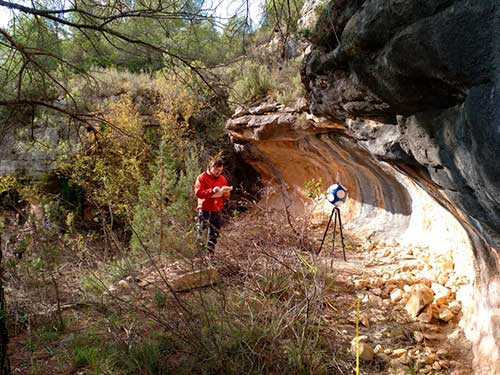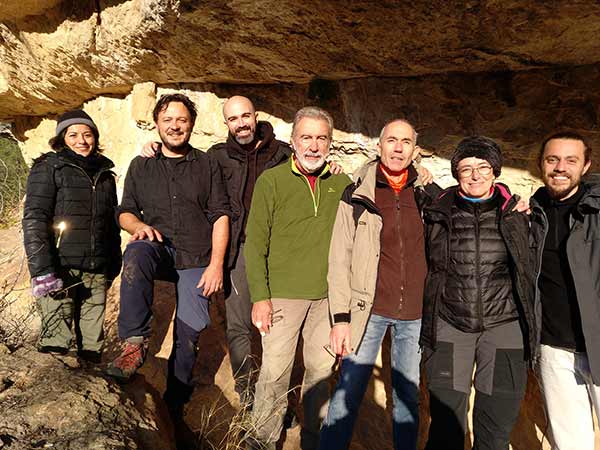By Tommaso Mattioli, Senior Researcher
I always take notes on everything during rock art surveys and today, as I was reading my own observations, questions and thoughts recorded during the last fieldwork season in Catalonia, I felt a little uneasy. On the one hand, I was enjoying them as they reignited my adventurous spirit and reminded me of what it is I love about being outdoors exploring, but on the other, they were hard to read because I perceived them as a sort of official notification that something had changed radically. In fact, like many thousands of other people, I’m now confined to my apartment and greatly missing those fieldwork programmes that were such good experiences (and hopefully will be again). Sadly, this pandemic has had a considerable impact on the activities planned by the Artsoundscapes project this year. It was just two months ago that I was discussing with Dr Tilman Lenssen-Erz (University of Cologne), an expert in Namibian rock art and a colleague in the Artsoundscapes project, and Dr Neemias Santos da Rosa (University of Barcelona), the newest member of our project, about how we could camp in the remote areas of the Brandberg (Daureb) inselberg without amenities such as bathrooms, running water and electricity. And, I should also add, that the likelihood of experiencing loneliness was indeed considered at that time – or at least by me – as an ultimate benefit of such fieldwork. Today, however, two months after that conversation, with our freedom of movement ending at our own front doors, a previously unuttered question arises: how long will it take for us to return to camping in the open air and resuming the fieldwork season for the Artsoundscapes project?
Today this question is even more baffling in relation to Catalonia. We actually started the survey of rock art sites in this area last November. However, we were forced to suspend it when Spain declared a state of emergency on 14 March 2020. Ironically, the last rock art site we visited before the lockdown was Roca Roja (municipality of La Lacuna), a small shelter just over ten kilometres from Igualada, the first area in which the Covid-19 lockdown restrictions were introduced (March 12) and were even more draconian than in the rest of Spain. The town of Igualada and the Conca d’Òdena Valley were actually cut off by the Mossos d’Esquadra (the Catalan police) from the rest of the country in a lockdown within a lockdown. It’s hard to believe that the road to reach that place, a gentle forest-covered hill in a quiet landscape with a picturesque cliff and a shelter decorated with Levantine paintings, has until very recently been sealed off by a “Checkpoint Charlie”-style police control post. Igualada is also where Dr Jordina Sales Carbonell, an Artsoundscapes team member, lives and where she is currently confined until the lockdown is lifted (note: she recently wrote a blog entry on another pandemic that took place some 1,500 years ago in Europe). Finally, the third aspect of this crisis that leaves me speechless is related to the equipment we developed for the Artsoundscapes fieldwork. Even though there is no scientific proof behind Murphy’s Law (“Anything that can go wrong will go wrong”), this is an analogy that might help in understanding my frustration: having successfully designed extremely portable devices for taking acoustic measurements in remote and demanding landscapes, it is now us who cannot move! Like the modern heroes in Xavier de Maistre’s book “Voyage autour de ma chambre”, only few steps are needed to circumnavigate our space, with trains, planes and even cars no longer allowed. In fact, some of the equipment has yet to arrive, as China was the first country to succumb to the pandemic, and some of the orders were to be built in the Wuhan area!
Not everything is looking black. We managed, for example, to complete the acoustic survey of the Ulldecona rock art area. Also, although we weren’t able to do much fieldwork before the lockdown, we have had great opportunities for interdisciplinary work. On one of these occasions we explored the Les Covetes rock art sites in the Prades Mountains (18 November 2019). This is a group of three shelters with Levantine and Schematic rock art located close to the village of Siurana, a true vertical “El Dorado” for climbers because it is located in the middle of a series of steep yellow, grey and red limestone walls, slabs and overhangs that together form one of the most famous crags in Spain.

Acoustic measurements at the Les Covetes rock art site in the Prades Mountains (Catalonia, Spain)
The members of the Les Covetes team were the Artsoundscapes project PI, ICREA Research Professor Margarita Díaz-Andreu; the neurocognition expert Prof. Carles Escera, the senior project scientist (Brainlab, UB); Dr Ramon Viñas, rock art expert and project partner; Dr José Valenzuela, the author of our previous blog entry; Dr Ana María Alarcón, project junior postdoctoral researcher who specialises in anthropology and ethnomusicology; Damian Payo, visiting fellow from the University of Salta in Argentina and a specialist in sound design; and myself as senior postdoctoral researcher of the Artsoundscapes project. Without giving in to the temptation of sensationalising that day (during the pandemic every memory of our “past” life in the outdoors is imbued with mythology and hyperbole), I believe Spain had never seen a more varied audience interested in the acoustics of rock art sites as on that gloomy November day in Siurana. I will always remember that day as an opportunity to experiment with different approaches to rock art acoustics. There are no special travel stories with myriad trials, tribulations and adventures to share, just a simple scientific conversation in which everyone tossed into the mix any idea that came into his or her head. The purpose of that fieldwork was to put into some order the array of approaches and interpretations and to develop a shared methodology for measuring the acoustics of rock art landscapes. We did this in an actual rock art scenario.
In this blog post, I don’t wish to focus on the scientific results that emerged from that day, although in many ways they have contributed to refining our fieldwork procedure. I actually want to focus on what struck me the most: the opportunity to listen to real music at rock art sites. Before that day I had only had the opportunity to appreciate the real time acoustics of rock art sites through the response of artificial impulses, such as exponential sine-sweeps sounds played through a loudspeaker or impulsive sounds, such as the explosion of large air balloons or hand-clapping, whistling or shouting. I have never heard real music at rock art sites. I experienced this for the first time on that November day at Les Covetes I, when – following the advice of Prof. Escera and Dr Alarcón – we included in our tests the playback of a selection of songs. I was particularly impressed by Dikiboda Sombe, a song selected by Dr Alarcón from the repertoire of the Aka Pygmies in Africa. Of course, this song was not chosen for making comparisons between the music produced by the Pygmies, who are known as one of the oldest populations on the African continent, and the Levantine rock art creators. It was chosen because of its acoustic characteristics; it is purely vocal, consisting of a complex polyphony with rich harmonies from a chorus and is sung by females. Our intention was purely speculative (how female vocal polyphony would sound in a natural environment) and was not designed to suggest a relationship between the pre-modern peoples of Africa and Europe (in case you are curious, we also played jazz trumpets and Pavarotti). Physically, we played a song, but spiritually, I was moved and felt overwhelmed. The side of the canyon in Siurana acted like many mirrors, giving the impression of being in an acoustic space far larger than its actual size. I was mesmerised by the different paths along which the sound travelled through the meanders of the canyon, before it returned to us from unexpected directions. Moreover, hearing the long reverberation tail of those female voices coming from the rock art site gave me the impression that the rock shelter was a window opening onto a sanctuary.
What does it mean to witness something truly majestic? To feel something that you find deeply inspiring. From our ordinary experience as modern Western listeners, we are always searching for explanations of natural phenomena. However, despite the increasing number of scientific explanations for sound phenomena, spatial acoustics still remains sensational. And sometimes the places are so extraordinary that they border on the magical.

The team which explored the Les Covetes rock art site in November 2019. From left to right: Ana María Alarcón; Tommaso Mattioli; José Valenzuela; Ramon Viñas; Carles Escera; Margarita Díaz-Andreu; and Damian Payo.
